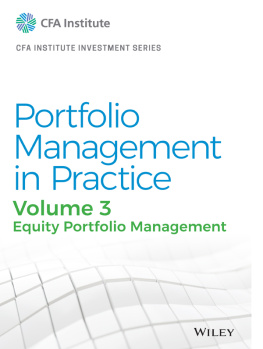Ludwig B. Chincarini - Quantitative Equity Portfolio Management
Here you can read online Ludwig B. Chincarini - Quantitative Equity Portfolio Management full text of the book (entire story) in english for free. Download pdf and epub, get meaning, cover and reviews about this ebook. year: 2023, publisher: McGraw Hill LLC, genre: Business. Description of the work, (preface) as well as reviews are available. Best literature library LitArk.com created for fans of good reading and offers a wide selection of genres:
Romance novel
Science fiction
Adventure
Detective
Science
History
Home and family
Prose
Art
Politics
Computer
Non-fiction
Religion
Business
Children
Humor
Choose a favorite category and find really read worthwhile books. Enjoy immersion in the world of imagination, feel the emotions of the characters or learn something new for yourself, make an fascinating discovery.

- Book:Quantitative Equity Portfolio Management
- Author:
- Publisher:McGraw Hill LLC
- Genre:
- Year:2023
- Rating:3 / 5
- Favourites:Add to favourites
- Your mark:
- 60
- 1
- 2
- 3
- 4
- 5
Quantitative Equity Portfolio Management: summary, description and annotation
We offer to read an annotation, description, summary or preface (depends on what the author of the book "Quantitative Equity Portfolio Management" wrote himself). If you haven't found the necessary information about the book — write in the comments, we will try to find it.
Quantitative Equity Portfolio Management — read online for free the complete book (whole text) full work
Below is the text of the book, divided by pages. System saving the place of the last page read, allows you to conveniently read the book "Quantitative Equity Portfolio Management" online for free, without having to search again every time where you left off. Put a bookmark, and you can go to the page where you finished reading at any time.
Font size:
Interval:
Bookmark:


Copyright 2023, 2006, by McGraw Hill. All rights reserved. Except as permitted under the United States Copyright Act of 1976, no part of this publication may be reproduced or distributed in any form or by any means, or stored in a database or retrieval system, without the prior written permission of the publisher.
ISBN: 978-1-26-426893-1
MHID: 1-26-426893-9
The material in this eBook also appears in the print version of this title: ISBN: 978-1-26-426892-4, MHID: 1-26-426892-0.
eBook conversion by codeMantra
Version 1.0
All trademarks are trademarks of their respective owners. Rather than put a trademark symbol after every occurrence of a trademarked name, we use names in an editorial fashion only, and to the benefit of the trademark owner, with no intention of infringement of the trademark. Where such designations appear in this book, they have been printed with initial caps.
McGraw Hill eBooks are available at special quantity discounts to use as premiums and sales promotions or for use in corporate training programs. To contact a representative, please visit the Contact Us page at www.mhprofessional.com.
This publication is designed to provide accurate and authoritative information in regard to the subject matter covered. It is sold with the understanding that the publisher is not engaged in rendering legal, accounting, or other professional service. If legal advice or other experts assistance is required, the services of a competent professional person should be sought.
From a declaration of principles jointly adopted by a committee of the
American Bar Association and a committee of publishers.
TERMS OF USE
This is a copyrighted work and McGraw-Hill Education and its licensors reserve all rights in and to the work. Use of this work is subject to these terms. Except as permitted under the Copyright Act of 1976 and the right to store and retrieve one copy of the work, you may not decompile, disassemble, reverse engineer, reproduce, modify, create derivative works based upon, transmit, distribute, disseminate, sell, publish or sublicense the work or any part of it without McGraw-Hill Educations prior consent. You may use the work for your own noncommercial and personal use; any other use of the work is strictly prohibited. Your right to use the work may be terminated if you fail to comply with these terms.
THE WORK IS PROVIDED AS IS. McGRAW-HILL EDUCATION AND ITS LICENSORS MAKE NO GUARANTEES OR WARRANTIES AS TO THE ACCURACY, ADEQUACY OR COMPLETENESS OF OR RESULTS TO BE OBTAINED FROM USING THE WORK, INCLUDING ANY INFORMATION THAT CAN BE ACCESSED THROUGH THE WORK VIA HYPERLINK OR OTHERWISE, AND EXPRESSLY DISCLAIM ANY WARRANTY, EXPRESS OR IMPLIED, INCLUDING BUT NOT LIMITED TO IMPLIED WARRANTIES OF MERCHANTABILITY OR FITNESS FOR A PARTICULAR PURPOSE. McGraw-Hill Education and its licensors do not warrant or guarantee that the functions contained in the work will meet your requirements or that its operation will be uninterrupted or error free. Neither McGraw-Hill Education nor its licensors shall be liable to you or anyone else for any inaccuracy, error or omission, regardless of cause, in the work or for any damages resulting therefrom. McGraw-Hill Education has no responsibility for the content of any information accessed through the work. Under no circumstances shall McGraw-Hill Education and/or its licensors be liable for any indirect, incidental, special, punitive, consequential or similar damages that result from the use of or inability to use the work, even if any of them has been advised of the possibility of such damages. This limitation of liability shall apply to any claim or cause whatsoever whether such claim or cause arises in contract, tort or otherwise.
T his is an ambitious book that both develops the broad range of artillery employed in quantitative equity investment management and also provides the reader with a host of relevant practical examples. While the authors firmly take the view that active management can be rewarded, their book offers a solid practitioners guide to quantitative passive management in the efficient-market/index-fund world on the one hand and to active managers on the other. Far too often quantitative management is equated with passive management, and active quantitative management is thought to be an oxymoron. The authors rigorous dispelling of this tired canard opens the way for the traditional active manager to make use of quantitative tools. Readers of this book soon learn that quantitative management is a technology that they can use to hone their evaluation of their fundamental ideals, implement them successfully, and finally, control the risk of the portfolios they manage while doing so.
Often investment ideas are anomalies that fit uncomfortably, if at all, with neoclassical efficient-market theories. Typically, such anomalies are observations formed from studying historical stock market returns. This book surveys the rich collection of anomalies that form the basis for much of what is current practice in the active quantitative arena. The student of portfolio management who is interested in learning what academics and empiricists have discovered will find this of particular interest. What about the small-firm effect or momentum? This book is an excellent place to introduce the manager to these important anomalies.
But where this book excels is in melding theory with practice. Issues of liquidity, leverage, market neutrality, transactions costs, and the pitfalls and virtues of backtesting that are so often skirted in other treatments take center stage here. So, too, there is an extensive analysis of optimal after-tax portfolio management, a topic often not even mentioned in other books. Throughout this book, the authors expend much useful effort on ridding their analysis of naive reliance on mathematics at the expense of practicality.
While the mathematics can at times be demanding, it is about at the level of the CFA requirements and should be well within the command of the analytic abilities of most portfolio managers.
Helpfully, the prose is lively and far removed from the usual pedantry that surrounds mathematics in finance. Extensive questions test the readers understanding and make this book perfectly suited to the needs of an advanced course in investment management at the MBA or PhD level.
Stephen A. Ross
The late Franco Modigliani Professor of
Finance and Economics
Massachusetts Institute of Technology
T he world of active portfolio management has been changing over the last few years to become more quantitative in nature. This trend is inspiring because it lends itself to a more controlled approach to asset management, which ultimately benefits individual and institutional investors. In some ways quantitative asset management is an old field, but in many ways its a very new field that has bundled together lots of old concepts. It is a vast and diverse field because quantitative managers use a variety of different techniques to manage their portfolios. Despite this diversity, though, there are central themes that remain at the core of the work of most quantitative asset management firms.
When we were first introduced to the field of quantitative portfolio management, we sensed that a lot of the issues it covered were unclear not only to us but also to our colleagues. In fact, there was no formal, authoritative source on the topic. Naturally, through our years at Seoul National University, UC Berkeley, Harvard, and MIT, we learned many of the concepts related to quantitative portfolio management, such as statistics and basic financial theory. And through our years working for portfolio management companies, we learned some of the real-world aspects of the trade. Still, we never really had a comprehensive reference to turn to for an understanding of the nuts and bolts of quantitative equity portfolio management. We also would sometimes see practitioners approach this kind of management with holes in their analytics or listen to academics speak about the theory with no attention to the details of real-world portfolio management. We began teaching the concepts to students at our respective universities and realized that it would be useful to write a book on the subject that attempted to cover the whole spectrum of quantitative equity portfolio management, including the theoretical side and the practical side.
Font size:
Interval:
Bookmark:
Similar books «Quantitative Equity Portfolio Management»
Look at similar books to Quantitative Equity Portfolio Management. We have selected literature similar in name and meaning in the hope of providing readers with more options to find new, interesting, not yet read works.
Discussion, reviews of the book Quantitative Equity Portfolio Management and just readers' own opinions. Leave your comments, write what you think about the work, its meaning or the main characters. Specify what exactly you liked and what you didn't like, and why you think so.





